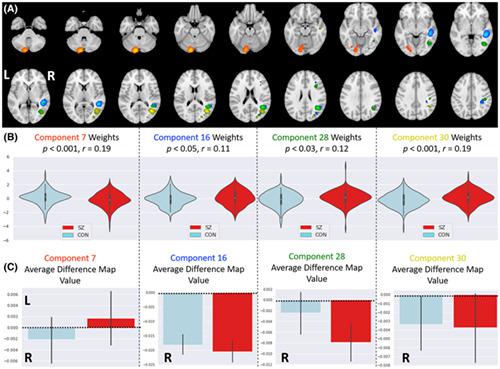当前位置:
X-MOL 学术
›
NMR Biomed.
›
论文详情
Our official English website, www.x-mol.net, welcomes your
feedback! (Note: you will need to create a separate account there.)
Covarying structural alterations in laterality of the temporal lobe in schizophrenia: A case for source-based laterality.
NMR in Biomedicine ( IF 2.7 ) Pub Date : 2020-03-23 , DOI: 10.1002/nbm.4294 Thomas P DeRamus 1 , Rogers F Silva 1 , Armin Iraji 1 , Eswar Damaraju 1 , Aysenil Belger 2 , Judith M Ford 3 , Sarah C McEwen 4 , Daniel H Mathalon 3 , Bryon A Mueller 5 , Godfrey D Pearlson 6, 7 , Steven G Potkin 8 , Adrian Preda 8 , Jessica A Turner 1, 9 , Jatin G Vaidya 10 , Theo G M van Erp 8 , Vince D Calhoun 1, 6, 9, 11
NMR in Biomedicine ( IF 2.7 ) Pub Date : 2020-03-23 , DOI: 10.1002/nbm.4294 Thomas P DeRamus 1 , Rogers F Silva 1 , Armin Iraji 1 , Eswar Damaraju 1 , Aysenil Belger 2 , Judith M Ford 3 , Sarah C McEwen 4 , Daniel H Mathalon 3 , Bryon A Mueller 5 , Godfrey D Pearlson 6, 7 , Steven G Potkin 8 , Adrian Preda 8 , Jessica A Turner 1, 9 , Jatin G Vaidya 10 , Theo G M van Erp 8 , Vince D Calhoun 1, 6, 9, 11
Affiliation

|
The human brain is asymmetrically lateralized for certain functions (such as language processing) to regions in one hemisphere relative to the other. Asymmetries are measured with a laterality index (LI). However, traditional LI measures are limited by a lack of consensus on metrics used for its calculation. To address this limitation, source-based laterality (SBL) leverages an independent component analysis for the identification of laterality-specific alterations, identifying covarying components between hemispheres across subjects. SBL is successfully implemented with simulated data with inherent differences in laterality. SBL is then compared with a voxel-wise analysis utilizing structural data from a sample of patients with schizophrenia and controls without schizophrenia. SBL group comparisons identified three distinct temporal regions and one cerebellar region with significantly altered laterality in patients with schizophrenia relative to controls. Previous work highlights reductions in laterality (ie, reduced left gray matter volume) in patients with schizophrenia compared with controls without schizophrenia. Results from this pilot SBL project are the first, to our knowledge, to identify covarying laterality differences within discrete temporal brain regions. The authors argue SBL provides a unique focus to detect covarying laterality differences in patients with schizophrenia, facilitating the discovery of laterality aspects undetected in previous work.
中文翻译:

精神分裂症颞叶侧向性的共变结构改变:基于源的侧向性的一个案例。
人类大脑的某些功能(例如语言处理)不对称地偏侧到一个半球相对于另一个半球的区域。不对称性是用侧向指数 (LI) 来衡量的。然而,传统的 LI 措施受到对其计算所用指标缺乏共识的限制。为了解决这一限制,基于源的偏侧性 (SBL) 利用独立成分分析来识别偏侧性特定的改变,识别跨受试者半球之间的共变成分。SBL 使用具有固有侧向性差异的模拟数据成功实施。然后将 SBL 与使用来自精神分裂症患者和无精神分裂症对照者样本的结构数据的体素分析进行比较。SBL 组比较确定了三个不同的颞区和一个小脑区,与对照组相比,精神分裂症患者的侧向性显着改变。以前的工作强调了与没有精神分裂症的对照相比,精神分裂症患者的侧向性减少(即左侧灰质体积减少)。据我们所知,这个试点 SBL 项目的结果是第一个识别离散时间大脑区域内的共变侧向差异。作者认为 SBL 提供了一个独特的焦点来检测精神分裂症患者的共变侧向性差异,促进发现以前工作中未发现的侧向性方面。以前的工作强调了与没有精神分裂症的对照相比,精神分裂症患者的侧向性减少(即左侧灰质体积减少)。据我们所知,这个试点 SBL 项目的结果是第一个识别离散时间大脑区域内的共变侧向差异。作者认为 SBL 提供了一个独特的焦点来检测精神分裂症患者的共变侧向性差异,促进发现以前工作中未发现的侧向性方面。以前的工作强调了与没有精神分裂症的对照相比,精神分裂症患者的侧向性减少(即左侧灰质体积减少)。据我们所知,这个试点 SBL 项目的结果是第一个识别离散时间大脑区域内的共变侧向差异。作者认为 SBL 提供了一个独特的焦点来检测精神分裂症患者的共变侧向性差异,促进发现以前工作中未发现的侧向性方面。
更新日期:2020-03-23
中文翻译:

精神分裂症颞叶侧向性的共变结构改变:基于源的侧向性的一个案例。
人类大脑的某些功能(例如语言处理)不对称地偏侧到一个半球相对于另一个半球的区域。不对称性是用侧向指数 (LI) 来衡量的。然而,传统的 LI 措施受到对其计算所用指标缺乏共识的限制。为了解决这一限制,基于源的偏侧性 (SBL) 利用独立成分分析来识别偏侧性特定的改变,识别跨受试者半球之间的共变成分。SBL 使用具有固有侧向性差异的模拟数据成功实施。然后将 SBL 与使用来自精神分裂症患者和无精神分裂症对照者样本的结构数据的体素分析进行比较。SBL 组比较确定了三个不同的颞区和一个小脑区,与对照组相比,精神分裂症患者的侧向性显着改变。以前的工作强调了与没有精神分裂症的对照相比,精神分裂症患者的侧向性减少(即左侧灰质体积减少)。据我们所知,这个试点 SBL 项目的结果是第一个识别离散时间大脑区域内的共变侧向差异。作者认为 SBL 提供了一个独特的焦点来检测精神分裂症患者的共变侧向性差异,促进发现以前工作中未发现的侧向性方面。以前的工作强调了与没有精神分裂症的对照相比,精神分裂症患者的侧向性减少(即左侧灰质体积减少)。据我们所知,这个试点 SBL 项目的结果是第一个识别离散时间大脑区域内的共变侧向差异。作者认为 SBL 提供了一个独特的焦点来检测精神分裂症患者的共变侧向性差异,促进发现以前工作中未发现的侧向性方面。以前的工作强调了与没有精神分裂症的对照相比,精神分裂症患者的侧向性减少(即左侧灰质体积减少)。据我们所知,这个试点 SBL 项目的结果是第一个识别离散时间大脑区域内的共变侧向差异。作者认为 SBL 提供了一个独特的焦点来检测精神分裂症患者的共变侧向性差异,促进发现以前工作中未发现的侧向性方面。











































 京公网安备 11010802027423号
京公网安备 11010802027423号